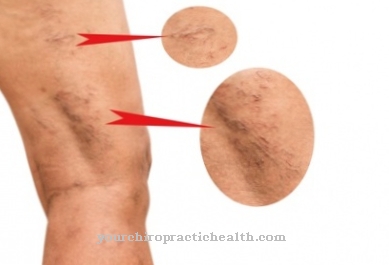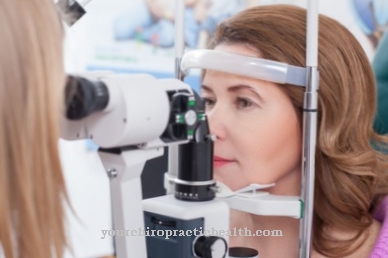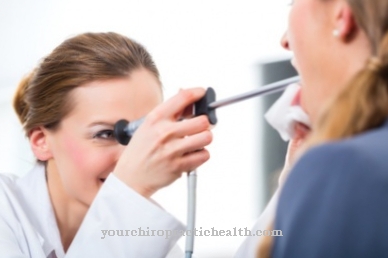The Venography is a radiological procedure that is used to map the venous system specifically to the veins of the legs. In most cases the indication arises from the suspicion of thrombosis or varicose veins. Because of the radiation and contrast medium exposure of venography, sonography is increasingly being used as an alternative to visualize veins.
What is the venography?

The term venography refers to the procedure of venography. This is a diagnostic radiological procedure that shows veins and enables the doctor to assess the venous structures. Phlebographs take place within phlebology and represent one of the most meaningful diagnostics for the detection of thrombi.
The venography method is used especially if there is suspicion of leg vein thrombosis. The representation of the individual veins is made possible by the injection of X-ray contrast medium, which is usually given into the superficial epifascial veins. With the radiological diagnostic method, functional recordings take place in different time windows, which allow a more detailed assessment of the venous system.
The procedure is rarely used on larger vena cava in the upper body. As an alternative to venography, sonography can be performed, which is used more frequently on larger-caliber veins than radiation-exposed venography.
Function, effect & goals
Leg phlebography is the most common venography. To carry out the examination, a congestion, which is also known as a tourniquet, is applied to the standing patient over the area of the ankle. In order to be able to visualize the veins, the patient receives a contrast medium injected into a vein on the back of the foot.
After the administration of the contrast agent, X-rays are taken of the leg, which are also referred to as target exposures. In arm phlebography, the examiner proceeds in the same way as the procedure described. The assessment of the X-ray images is therefore used particularly when thrombosis is suspected, because thromboses are expressed in the images as contrast medium recesses within the course of the vessels. Thromboses are blockages that can be traced back to blood clots and that can be clearly identified using venography.
During the course of the procedure, the venography creates a so-called phlebogram, which can provide the doctor with indications of thrombosis as well as signs of varicose veins and even their causes. In most cases, venographic examinations are used in medicine in combination with other examination methods, for example as a complement or in addition to them. Occasionally the most common venography is combined with a duplex sonography, especially in the case of unsuccessful duplex sonography. Although veins can now be mapped using less stressful methods, venography still has its advantages, especially on branched and thin veins of the lower leg or forearm.
The procedure also offers advantages for more complex varicose veins or for patients with post-thrombotic syndrome. The method is also advantageous over other methods for visualizing venous valves. Since venography is still associated with the most reliable statements, it is often used for varicose vein operations and their preparation. Only in rare cases is venography of the large vena cava in the upper body area. The same applies to the area of the abdomen. The technique used is the same as that just described, but usually requires larger amounts of contrast agent and higher flow rates.
In this modification of the procedure, one often speaks of an upper or lower cavography.This variant of venography has meanwhile been almost completely replaced by computed tomography and magnetic resonance tomography, since both methods provide significantly more additional information about the roughly equal stresses on the organism. The greatest advantage of venography is the complete display of branched or complex venous systems, which can take place over long distances. In addition, venography enables visual documentation of functional features, such as those that can arise when the extremities are moved or when the position of the venous system changes.
Risks, side effects & dangers
As a radiological procedure, venography is associated with some risks and side effects. This includes, for example, the radiation exposure that patients have to expose themselves to during the procedure. This burden is now extremely low and only has real consequences in the rarest of cases.
The injection of contrast media, which can cause allergies, carries a slightly higher risk. The most common side effects of contrast media are headache and nausea. After the administration of the contrast medium, the patient is asked to absorb a lot of fluid on the same day and to flush out the medium as quickly as possible. If contrast media stays in the body for too long, it puts stress on the kidneys in particular. Venography also has some disadvantages for the institution carrying it out, especially the costly and location-specific equipment technology and the need for radiologically experienced specialists. For this reason, modern alternatives are nowadays often preferred when assessing the veins, for example sonography.
Thromboses can be excluded or confirmed using the less stressful procedure. For large-caliber veins, MRI is also often used, which is, however, similarly stressful for the patient. Duplex color Doppler sonography is now used most frequently on all other veins, as this method is not associated with any radiation or contrast medium exposure for the patient. While ultrasound procedures can usually be carried out on an outpatient basis, procedures such as MRI, CT or venography are often linked to the inpatient admission of the patient.

























.jpg)

.jpg)
